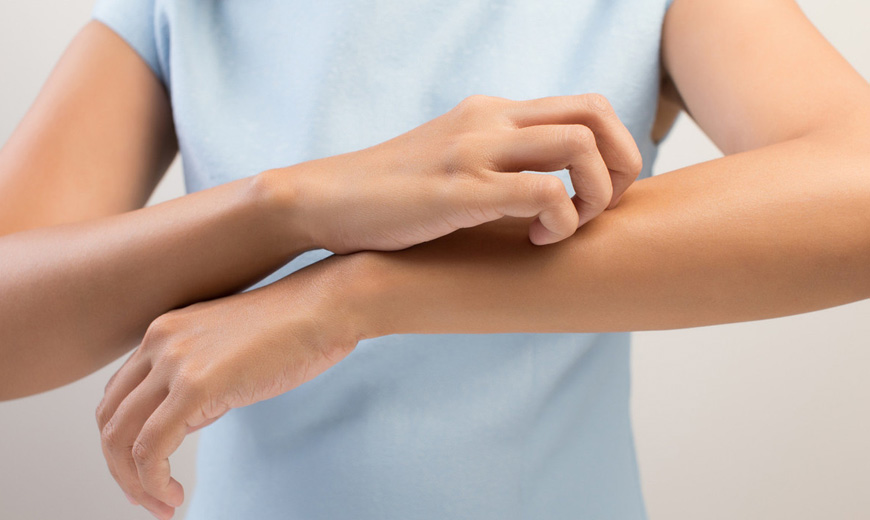Terra Pharmaceuticals

Fungal Infections
Fungal Infections
There are three main types of superficial fungal infections, caused by dermatophytes, Candida species and Pityrosporum organisms (also known as Malassezia infections and yeasts) (Gawkrodger 2007). Dermatophyte fungi cause disease by invading the keratinised outermost surface layer of the skin (the stratum corneum) and can also affect the hair and nails, which are composed of keratin. Most of these infections are caused by human-to-human spread, with the most common being Trichophyton rubrum. However, animal-to-human spread can occur occasionally; for example, Microsporum canis can be spread by dogs and cats.
Although dermatophyte infections are usually referred to as ‘Tinea’, tinea meaning worm in Latin, patients may be reassured to know that these skin infections are not caused by worms. Skin candidal (yeast) infections are most commonly caused by Candida albicans, an opportunistic skin pathogen. The other common commensal yeast infection is pityriasis versicolor, caused by Malassezia furfur. Recognising any underlying predisposing causes for a patient’s infection can be a key part of managing an infection and reducing the risk of recurrence.
Assessment and investigation
Skin problems are common in primary care, and it is estimated that about 15% of GP consultations concern dermatological problems (All Party Parliamentary Group on Skin 2004). Effective diagnosis and management of any skin condition requires a history of the complaint, as well as additional background information. This includes any therapies the patient may have already used (including over-the-counter preparations) and their effect, checking on the patient’s general state of health and any other concurrent treatment. Some skin diseases are inherited while others are infectious, so questions about known family history and specific household or occupational contacts can be helpful (Weller et al 2008). Most skin disease has a characteristic distribution as well as appearance, so it is important to ask about other affected sites and examine the patient fully. Patients can be embarrassed by their condition or reluctant to undress, so a full explanation should be given and, if appropriate, a chaperone offered. Many patients are uncertain about the implications of any infection, and it is important to offer the time and opportunity to discuss their concerns openly.
Although some diagnoses can be straightforward, as this article discusses there are often a number of different diagnoses to be considered (Ashton and Leppard 2004). In such cases investigations can be helpful, especially before commencing some types of therapy. Sampling is recommended before oral therapy is given for tinea capitis (Higgins et al 2000) or tinea pedis (Drug and Therapeutics Bulletin 2002). Skin scrapings from the most inflamed part of a lesion can be obtained using a blunt scalpel blade known as a ‘banana’ scalpel, held at 45˚ or less, to remove skin cells without cutting. Full-thickness nail clippings from areas of affected nails can be taken using a nail clipper, and associated debris below the nail should be included in the sample. Skin scrapings and hair roots can be obtained from the scalp, using a blade or commercially available sample brush. Neither scrapings nor clippings should be taken if antifungal treatment (either topical or oral) has been used in the previous two weeks as this can inhibit successful culture. In all cases no transport medium is required; ideally, the specimen can be placed in commercially obtainable mycology sachets and sent with the patient’s details to the laboratory. Fungal culture takes time; a microscopy result should be available in a fortnight and culture results after a month. Bacterial swabs may be helpful if a patient has paronychia (a skin infection at the nail margin), a kerion (an inflamed, boggy lesion that develops as an immune reaction to a fungal infection), or where secondary impetigo is suspected. A hand held Wood’s light, which emits long wavelength ultraviolet radiation, can be used in a darkened room to demonstrate fluorescence in some fungal infections. M. canis fluoresces green, and M. Furfur yellow-green. However, some Trichophyton species do not fluoresce, particularly Trichophyton tonsurans, which is now recognised as the primary cause of childhood scalp ringworm in British cities (Fuller et al 2003). Punch biopsy is not typically used to investigate suspected fungal infections. In all cases, the patient’s clinical symptoms and the appearance and distribution of the rash, with scrapings if appropriate, remain the best guide to management.
Dermatophyte infections
Tinea corporis :This is the typical ‘ringworm’ of the trunk and limbs and appears as a slowly growing, roughly annular (ring-like) lesion with a slightly raised and inflamed, reddened, well-defined leading edge. The degree of itchiness patients describe is variable. The lesion may initially be solitary, but over time other similar lesions usually develop and older plaques start to show central healing. Lesions may coalesce. Most lesions have fine scales, especially at the leading edge, where the fungus is actively invading the keratin layers of the skin. All such patients should be checked for other sites of infection, particularly the groin and feet (Noble et al 1998). Differential diagnosis Not all scaled annular lesions are tinea. Possible alternative diagnoses include psoriasis, discoid eczema, the herald and initial patches of pityriasis rosea. Granuloma annulare is similar in appearance, but is not scaled. Checking for other sites of the rash and taking skin scrapings can help confirm the diagnosis. Tinea pedis Athlete’s foot is the most common dermatophyte infection. It usually starts in the webspaces of the third and fourth toe as an itchy, scaled, inflamed rash . The skin gradually breaks down, appearing red and/or white and macerated (soggy), with increasing soreness, painful fissures and sometimes an unpleasant odour. If untreated, secondary bacterial infection is common. The erythematous, itchy rash can spread over the dorsum and sole of the foot. Tinea pedis is common in young adults, especially those sharing communal washing facilities, such as at swimming baths, or wearing occlusive footwear. It is more common in hot, humid conditions. Tinea pedis can trigger pompholyx, which is a particular type of eczema found on the palms and soles, characterised by small itchy vesicles. An alternative presentation is of dry, hyperkeratotic scales over the sole and heel, known as ‘moccasin foot’ (Noble et al 1998).
Differential diagnosisTinea pedis is usually self-evident, but inflammatory fungal involvement of the sole is unusual if the webspaces are unaffected. In such cases eczema or psoriasis should be considered.
Tinea cruris :Tinea of the groin is more common in adult men. It usually presents as a unilateral or bilateral faintly erythematous rash, affecting the groin and perineal region, and spreading over the inner thigh where it is often more noticeably scaly. Many patients have associated tinea pedis. Hot weather, obesity and wearing tightly fitting underclothes are predisposing factors. Differential diagnosis Bacterial and candidal intertrigo, which is a superficial infection of the skin folds and creases, may be alternative primary diagnoses or represent secondary infections in the groin. Candidal infections, unlike tinea, often involve the scrotum and penis. Flexural psoriasis can mimic tinea (Ashton and Leppard 2004).
Tinea capitis :This is more commonly known as scalp ringworm. Its visibility and possible effect on hair growth can be distressing for patients and, as it is more common in children, their carers. The infection can affect both the hair and skin of the scalp. Human-to-human transmission of T. tonsurans is now the most common cause (Fuller et al 2003), and outbreaks can occur in schools. However, animal-to-human infections tend to cause more severe symptoms. Nearly all patients experience itching, and most develop a roughly annular reddened scaly patch within which broken hairs, and some diffuse hair loss, are seen. In some cases only the endothrix (the interior of the hair shaft) is infected, in which case no or minimal external inflammation may occur. More commonly, both the ectothrix (exterior hair shaft) and skin become involved, producing visible inflammatory symptoms. Occasionally, the infection progresses to produce a kerion, especially in African-Caribbean children, who seem particularly vulnerable (Gawkrodger 2007). A kerion is a painful, boggy lesion that often oozes pus due to secondary infection. It can be associated with substantial hair loss, sometimes permanent, because of residual scarring. It is important to diagnose a kerion so that surgical intervention (incision and drainage) of a presumed bacterial abscess is avoided. This can often make the condition much worse. Differential diagnosis Scalp psoriasis and seborrheic eczema can produce scaly scalp lesions, as can bacterial folliculitis. Alopecia areata produces well-defined areas of non-inflammatory hair loss. Trichophyton infections of the hands (tinea manuum) and beard area (tinea barbae) occur comparatively infrequently and, if suspected, further advice should be sought in terms of possible differential diagnoses (Ashton and Leppard 2004). Tinea unguium (onychomycosis) Fungal toenail infections are common and believed, in many cases, to be related to pre-existing tinea pedis. The infection usually begins in the free edge of the nail, and often affects the great toe first. It is usually asymmetrical. The nail becomes discoloured, either white or yellow, and gradually becomes more brittle and crumbly. Over time more nails become involved – although the spreading infection is often painless and with minimal or no visible inflammation. As nail damage progresses, problems with footwear and mobility can occur, particularly if the nail becomes painful and thickened (onychogryphosis). Fingernails are rarely involved, and usually only if trichophyte hand infection is present.
Differential diagnosis Many diseases can cause nail changes; psoriatic nail disease, in particular, can mimic onychomycosis. Onycholysis, in which the nail plate separates from the nail bed, can cause discolouration and thickening of the nails. Onychogryphosis produces thickening and distortion of the nail and is more common after chronic trauma (including that caused by illfitting footwear) or in older patients (Stone and Dawber 2000).
Management
Dermatophyte infections The majority of mild skin infections (tinea corporis, cruris and pedis) require local, topical therapy with either imidazole preparations or the allylamine, terbinafine. Most patients require a two-week course of treatment, extended by up to a week after all signs of the infection have resolved to ensure complete clearance. If several sites are involved, topical treatments have failed or if the hair or nails are affected, then systemic (oral) antifungals are recommended. Laboratory confirmation of infection is preferred before systemic prescribing unless there is a high index of suspicion. This is because of the sometimes prolonged treatment courses required (at least three months in the case of infected toe nails), the rare but potentially serious side effects, and the non-urgent nature of the condition
General skin care advice for patients
• Keep the affected skin clean and dry.
• Wash daily using an emollient.
• Dry the affected area carefully, especially the toe spaces and skin folds.
• Use your own towel.
• Wash shared showers, baths and mats with disinfectant.
• Wash socks, towels, bath mats and appropriate clothing at a
• temperature of at least 60˚C.
• Wash floors regularly where you might walk barefoot.
Candidal infections
As candidiasis is an opportunistic pathogen that preferentially occurs in at-risk individuals, all patients with this infection should be reviewed for potential predisposing factors. It is worthwhile checking a patient’s urine sample to identify unrecognised diabetes. Pregnancy, obesity, systemic immunosuppression and poor personal hygiene are accepted risk factors (Weller et al 2008). Oral antibiotics, and the combined contraceptive pill, also predispose patients to candidal infections. Repeatedly immersing hands in water and hot, humid environments can also trigger candidal infections. Candidal intertrigo Intertrigo describes the process of skin inflammation that occurs when occluded moist skin surfaces rub together and macerate; common sites are the axillary, inguinal and sub-mammary skin folds and immersed hand webspace areas. Candidal infection produces a moist, bright red, glazed appearance which can extend beyond the body fold. The edge can show scaling and neighbouring small satellite lesions. The area is sore and uncomfortable. Differential diagnosis Flexural psoriasis, dermatophyte infections (which are usually drier and lack satellite lesions), erythrasma (a superficial bacterial infection caused by Corynebacterium minutissimum, which fluoresces coral pink under a Wood’s light) and flexural seborrhoeic dermatitis should all be considered. In babies, ‘napkin’ dermatitis, caused by direct irritation, is common but the flexural creases are unaffected.
Oral candidiasis Thrush represents patches of whitish adherent patches of Candida on the tongue, lips or oral mucosa. If wiped off, a reddish base is visible. It is common in infants. In healthy adults, aside from individuals who wear dentures, thrush is unusual and patients should be considered for further assessment (Akpan and Morgan 2002).
Genital candidiasis In females this usually causes a combination of vulvovaginal itching and soreness, including potential superficial dyspareunia (pain during intercourse), with a non-offensive whitish vaginal discharge.
More severe cases cause a rash extending into the perineal and groin areas, with associated fissuring and evidence of local excoriation. In males, candidal balanitis causes similar reddish patches on the glans penis, but is often mild and asymptomatic.
Differential diagnosis Infections such as Trichomonas and bacterial vaginosis can cause similar symptoms or can, less commonly, co-exist. Non-infective causes, such as irritant eczema or lichen sclerosis, may cause similar symptoms of itching and soreness. Any patient with persistent vulval symptoms, apparently unresponsive to therapy, should be referred for a specialist dermatology assessment (Sobel 2007). Paronychia Acute nail fold infections are bacterial or, less commonly, herpetic, but chronic infection with a combination of opportunistic bacteria and Candida species produces a persistent infection between the nail fold and nail plate. This generally only occurs following recurrent immersion of the hands in water. The site is painful and swollen, may intermittently ooze pus, and the adjacent nail plate can become discoloured and ridged. Candida is the most common cause of fingernail onychomycosis.
Management of candidal infections
Identifying and encouraging the management of any underlying predisposing risks is the health professional’s key task in treating patients with candidal infections, as this will improve symptoms and reduce recurrence. Keeping an area dry, using emollients to wash and soothe the rash, and avoiding soap-based products will help relieve symptoms and improve healing.
If the area is inflamed, using a combination of an antifungal and a topical corticosteroid might be more helpful initially. If swab culture suggests a secondary bacterial pathogen, this can also be concomitantly treated.
The management of recurrent vulvovaginal candidiasis should include treating the partner.
Malassezia infections
Pityriasis versicolor This is the only common non-candidal yeast infection. It causes an often recurrent rash, typically on the upper trunk, which is asymptomatic or at most very slightly itchy. The round and oval lesions vary widely in size (0.5-3cm), have a well-demarcated edge and, on pale skin, appear coppery-brown or fawn. On dark or suntanned skin the lesions appear pale, and often this effect upsets patients and causes them to consult. Most patients are young adults. Pityriasis versicolor can be regarded as non-infectious, and patients can be reassured that effective treatment will lead to a recovery of normal skin pigmentation.
Differential diagnosis Guttate psoriasis, pityriasis rosea and truncal seborrhoeic eczema can mimic the lesions. Vitiligo is the commonest true depigmenting disorder; this is non-scaling, tends to cause larger lesions and affects the limbs and face (Oakley 2008).
Management Pityriasis versicolor can be treated effectively with a topical imidazole applied to all affected areas two or three times a day for two to four weeks. Traditionally selenium shampoo or ketoconazole shampoo, have been used, but can be messy to apply.
References:
1.Akpan A, Morgan R (2002) Oral candidiasis. Postgraduate Medical Journal. 78, 922, 455-459. All Party Parliamentary Group on Skin (2004) Report on Dermatological Training for Health Professionals. Houses of Parliament, London. 2. Ashton R, Leppard B (2004), Differential Diagnosis in Dermatology. Third edition. Radcliffe Publishing, Abingdon. 3. British National Formulary (2009) British National Formulary. Number 57. 4. Drug and Therapeutics Bulletin (2002) Getting rid of athlete’s foot. Drug and Therapeutics Bulletin. 40, 7, 53-54. 5. Fuller LC, Child FJ, Midgley G, Higgins EM (2003) Diagnosis and management of scalp ringworm. British Medical Journal. 326, 7388, 539-541. 6. Gawkrodger D (2007) Dermatology:An Illustrated Colour Text. Fourth edition. Churchill Livingstone, Edinburgh. Higgins EM, Fuller LC, Smith CH (2000) Guidelines for the management of tinea capitis. 7.British Journal of Dermatology. 143, 1, 53-58. NHS Clinical Knowledge Summaries Fungal Skin Infection 10. Noble SL, Frobes RC, Stamm PL (1998) Diagnosis and management of common tinea infections. American Family Physician. 58, 1, 163-173. Oakley A (2009) Pityriasis Versicolor. 11.Sobel JD (2007) vulvovaginal candidosis. The Lancet. 369, 9577, 1961-1971. 12.Stone N, Dawber R (2000) Toenail onychomycosis can cause serious problems. British Medical Journal. 320, 7232, 448. 13.Weller R, Hunter JAA, Savin J, Dahl MV (2008) Clinical Dermatology. Fourth edition. Wiley-Blackwell, Chichester. Management of common fungal infections in primary care Parker J (2009) 14.Management of common fungal infections in primary care. 23, 43, 42-46. Date of acceptance: May 19 2009. ar&t &science dermatology focus





